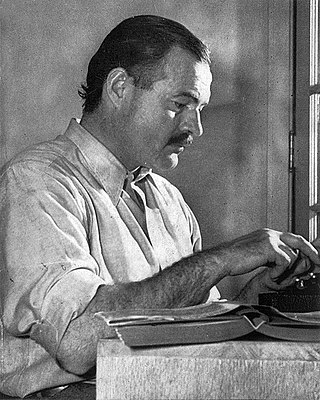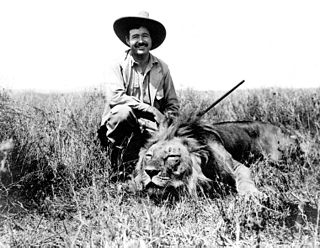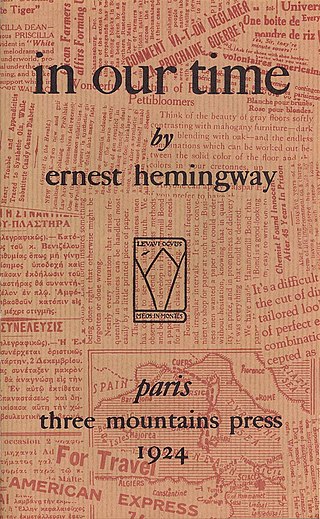Related Research Articles

Ernest Miller Hemingway was an American novelist, short-story writer and journalist. Best known for an economical, understated style that significantly influenced later 20th-century writers, he is often romanticized for his adventurous lifestyle, and outspoken and blunt public image. Most of Hemingway's works were published between the mid-1920s and mid-1950s, including seven novels, six short-story collections and two non-fiction works. His writings have become classics of American literature; he was awarded the 1954 Nobel Prize in Literature, while three of his novels, four short-story collections and three nonfiction works were published posthumously.

"The Snows of Kilimanjaro" is a short story by American author Ernest Hemingway first published in August 1936, in Esquire magazine. It was republished in The Fifth Column and the First Forty-Nine Stories in 1938, The Snows of Kilimanjaro and Other Stories in 1961, and is included in The Complete Short Stories of Ernest Hemingway: The Finca Vigía Edition (1987).
"The Killers" is a short story by Ernest Hemingway, first published in Scribner's Magazine in 1927 and later republished in Men Without Women,Snows of Kilimanjaro, and The Nick Adams Stories. Set in 1920s Summit, Illinois, the story follows recurring Hemingway character Nick Adams as he has a run-in with a pair of hitmen, who are seeking to kill a boxer, in a local restaurant.

In Our Time is the title of Ernest Hemingway's first collection of short stories, published in 1925 by Boni & Liveright, New York, and of a collection of vignettes published in 1924 in France titled in our time. Its title is derived from the English Book of Common Prayer, "Give peace in our time, O Lord".

True at First Light is a book by American novelist Ernest Hemingway about his 1953–54 East African safari with his fourth wife Mary, released posthumously in his centennial year in 1999. The book received mostly negative or lukewarm reviews from the popular press and sparked a literary controversy regarding how, and whether, an author's work should be reworked and published after his death. Unlike critics in the popular press, Hemingway scholars generally consider True at First Light to be complex and a worthy addition to his canon of later fiction.

Across the River and Into the Trees is a novel by American writer Ernest Hemingway, published by Charles Scribner's Sons in 1950, after first being serialized in Cosmopolitan magazine earlier that year. The title is derived from the last words of U.S. Civil War Confederate General Thomas J. "Stonewall" Jackson: “Let us cross over the river and rest under the shade of the trees.”

"The Short Happy Life of Francis Macomber" is a short story by Ernest Hemingway. Set in Africa, it was published in the September 1936 issue of Cosmopolitan magazine concurrently with "The Snows of Kilimanjaro". The story was eventually adapted to the screen as the Zoltan Korda film The Macomber Affair (1947).

"Soldier's Home" is a short story by Ernest Hemingway. It was included in the 1925 Contact Collection of Contemporary Writers and published by Boni & Liveright in Hemingway's 1925 New York collection short stories, In Our Time.
Nicholas Adams is a fictional character, the protagonist of two dozen short stories and vignettes written in the 1920s and 1930s by American author Ernest Hemingway. Adams is partly inspired by Hemingway's own experiences, from his summers in Northern Michigan at his family cottage to his service in the Red Cross ambulance corps in World War I. The first of Hemingway's stories to feature Nick Adams was published in his 1925 collection In Our Time, with Adams appearing as a young child in "Indian Camp", the collection's first story.
"A Day's Wait" is a short story by Ernest Hemingway published in his 1933 short story collection Winner Take Nothing, which portrays a young boy's reaction to becoming ill.

The iceberg theory or theory of omission is a writing technique coined by American writer Ernest Hemingway. As a young journalist, Hemingway had to focus his newspaper reports on immediate events, with very little context or interpretation. When he became a writer of short stories, he retained this minimalistic style, focusing on surface elements without explicitly discussing underlying themes. Hemingway believed the deeper meaning of a story should not be evident on the surface, but should shine through implicitly.

"Big Two-Hearted River" is a two-part short story written by American author Ernest Hemingway, published in the 1925 Boni & Liveright edition of In Our Time, the first American volume of Hemingway's short stories. It features a single protagonist, Hemingway's recurrent autobiographical character Nick Adams, whose speaking voice is heard just three times. The story explores the destructive qualities of war which is countered by the healing and regenerative powers of nature. When it was published, critics praised Hemingway's sparse writing style and it became an important work in his canon.

Hemingway's Adventures of a Young Man is a 1962 American adventure film directed by Martin Ritt based on Ernest Hemingway's semi-autobiographical character Nick Adams, and featuring Richard Beymer as Adams. A.E. Hotchner wrote the screenplay, originally calling the film Ernest Hemingway's "Young Man". The cast includes Diane Baker, Jessica Tandy, Ricardo Montalbán, Eli Wallach, Arthur Kennedy and Paul Newman. It was released in July 1962.

"The Three-Day Blow" is a short story written by Ernest Hemingway, published in the 1925 New York edition of In Our Time, by Boni & Liveright. The story is the fourth in the collection to feature Nick Adams, Hemingway's autobiographical alter ego.

"Indian Camp" is a short story written by Ernest Hemingway. The story was first published in 1924 in Ford Madox Ford's literary magazine Transatlantic Review in Paris and republished by Boni & Liveright in Hemingway's first American volume of short stories In Our Time in 1925. Hemingway's semi-autobiographical character Nick Adams—a child in this story—makes his first appearance in "Indian Camp", told from his point of view.

"The Battler" is a short story written by Ernest Hemingway, published in the 1925 New York edition of In Our Time, by Boni & Liveright. The story is the fifth in the collection to feature Nick Adams, Hemingway's autobiographical alter ego.

"The Doctor and the Doctor's Wife" is a short story by Ernest Hemingway, published in the 1925 New York edition of In Our Time, by Boni & Liveright. The story is the second in the collection to feature Nick Adams, Hemingway's autobiographical alter ego. "The Doctor and the Doctor's Wife" follows "Indian Camp" in the collection, includes elements of the same style and themes, yet is written in counterpoint to the first story.

"Cross Country Snow" is a short story written by Ernest Hemingway. The story was first published in 1924 in Ford Madox Ford's literary magazine Transatlantic Review in Paris and republished by Boni & Liveright in Hemingway's first American volume of short stories In Our Time in 1925. The story features Hemingway's recurrent autobiographical character Nick Adams and explores the regenerative powers of nature and the joy of skiing.
"On Writing" is a story fragment written by Ernest Hemingway which he omitted from the end of his short story, "Big Two-Hearted River", when it was published in 1925 in In Our Time. It was then published after Hemingway's death in the 1972 collection The Nick Adams Stories.
"Ten Indians" is a short story by American writer Ernest Hemingway, featuring protagonist Nick Adams, Hemingway's autobiographical alter ego. It was published in 1927 in the collection Men Without Women. The title is derived from a comment made by Mr. Garner - "That makes nine of them" - after moving an Indian who had passed out on the road. The title also alludes to the 1864 children's song, Ten Little Indians.
References
- ↑ "Hemingway's Writing Style" (PDF). The Big Read. National Endowment for the Arts. Archived from the original (PDF) on 2012-04-29.
- ↑ Hemingway, Ernest; George Plimpton. "The Art of Fiction No. 21". Paris Review. Retrieved 6 January 2014.